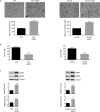Adipocytes reprogram prostate cancer stem cell machinery
- PMID: 36940071
- PMCID: PMC10409918
- DOI: 10.1007/s12079-023-00738-x
Adipocytes reprogram prostate cancer stem cell machinery
Abstract
It is now well-established that an obese condition correlates with a higher risk of prostate cancer (PCa). A crosstalk between adipose tissue and PCa has been observed but is still poorly characterized. Herein, we demonstrated that 3T3-L1 adipocyte conditioned media (CM) could endow PC3 and DU145 PCa cells with stemness properties, by stimulating their sphere formation ability and promoting CD133 and CD44 expression. Moreover, after exposure to adipocyte CM both PCa cell lines underwent partial epithelial-to-mesenchymal transition (EMT), with E-/N-cadherin switch and Snail upregulation. Specifically, these changes in PC3 and DU145 cell phenotype were accompanied by increased tumor clonogenic activity and survival, as well as by enhanced invasion, anoikis resistance and matrix metalloproteinase (MMP) production. Finally, adipocyte CM-treated PCa cells exhibited reduced responsiveness to both docetaxel and cabazitaxel, demonstrating greater chemoresistance. Overall, these data indicate that adipose tissue can effectively contribute to PCa aggressiveness by reprogramming the cancer stem cell (CSC) machinery. Adipocytes endow prostate cancer cells with stem-like properties and mesenchymal traits, increasing their tumorigenicity, invasion and chemoresistance.
Keywords: Adipocytes; Cancer stem cells; Chemoresistance; EMT; Metastasis; Obesity; Prostate cancer.
© 2023. The Author(s).
Conflict of interest statement
The authors declare no conflict of interest.
Figures





References
-
- Cao Y, Giovannucci E. Obesity and prostate cancer. In: Pischon T, Nimptsch K, editors. Obesity and cancer. Cham: Springer International Publishing; 2016. pp. 137–153.
Grants and funding
- 2015B7M39T_004/PRIN 2015
- Progetto di Eccellenza (Department of Pharmacological/Ministero dell'Istruzione, dell'Università e della Ricerca
- Biomolecular Sciences/Ministero dell'Istruzione, dell'Università e della Ricerca
- Università degli Studi di Milano)/Ministero dell'Istruzione, dell'Università e della Ricerca
- Fellowship for Italy/Associazione Italiana per la Ricerca sul Cancro
LinkOut - more resources
Full Text Sources
Research Materials
Miscellaneous

